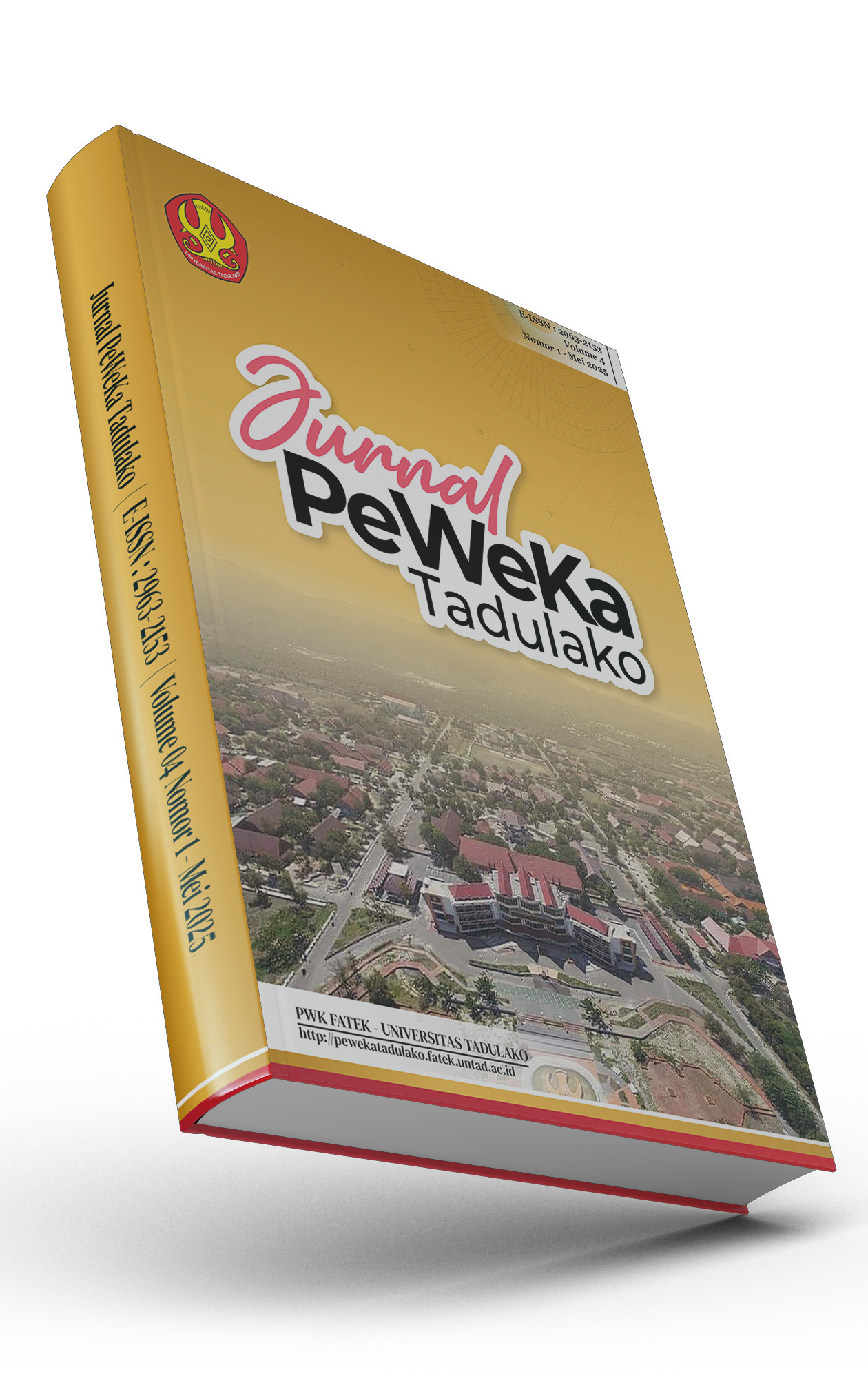Rekonstruksi Ruang Peri-Urban: Interaksi Sosial-Ekonomi Dalam Dinamika Kutub Pertumbuhan dan Proses Gentrifikasi di Kawasan Perkotaan Bulukumba
DOI:
https://doi.org/10.22487/peweka.v4i1.47Keywords:
Growth Pole, Transformation , Gentrification, Interaction Pattern, Peri-urbanAbstract
The urban development of Bulukumba Regency exhibits a spatial expansion trend toward peri-urban areas, historically marked by the emergence of new growth poles. This phenomenon reflects ongoing urbanization and generates complex social dynamics through population migration from both rural and urban regions. Migration is driven by the pursuit of economic opportunities, more affordable housing, and lifestyle shifts increasingly oriented toward urban preferences. This study aims to analyze the influence of growth poles on morphological changes and to explore the role of gentrification in shaping socio-economic interaction patterns. A quantitative approach is employed, utilizing spatial analysis, correlation testing, and grounded theory to examine the phenomenon holistically. The findings indicate that both physical and non-physical factors are influenced by fragmented growth patterns, often concentrated around economic potential and high accessibility. The formation of growth poles is seen as a consequence of leapfrogging centrifugal urban expansion, whereby central urban development stimulates the emergence of new development clusters in peri-urban zones. These zones act as transitional spaces offering economic opportunities with lower living costs, making them attractive destinations for urban migrants facing socio-economic pressures in their places of origin. Gentrification is not merely a physical revitalization process but also functions as a socio-economic filtering mechanism that reconstructs cultural identity and values within industrialized spaces. The shift from an agrarian to an urban economy marks a structural transformation shaped by market efficiency, competitiveness, and the rationality of spatial capitalism.
References
Asmirawati. (2018). Perubahan Fungsi Ruang Kawasan Pinggiran Kota Bulukumba. Universitas Bosowa Makassar.
Iqbal, M. (2020). Kutub Pertumbuhan dan Gentrifikasi pada Kawasan Pinggiran Kota Makassar. Universitas Bosowa Makassar.
Iqbal, M., Surya, B., & Syafri. (2020). Kutub Pertumbuhan dan Gentrifikasi pada Kawasan Pinggiran Kota Makassar. Urban and Regional Studies Journal, 3(1), 13-22.
Mukmin, T. (2018). Hubungan Pendidikan dan Stratafikasi Sosial. El – Ghiroh, 15(2).
Pratiyudha, P. P. (2019). Gentrifikasi dan Akar – Akar Masalaha Sosial: Menakar Identifikasi, Diagnosis, dan Treatment Proses Gentrifikasi sebagai Masalah Sosial. Reka Ruang, 2(1), 27-38. DOI: 10.33579/rkr.v2i1.1148.
Prihatin, R. B. (2015). Alih Fungsi Lahan di Perkotaan (Studi Kasus di Kota Bandung dan Yogyakarta. Aspirasi, 6(2), 105-118. DOI: https://doi.org/10.33579/rkr.v2i1.1148.
Radhinal, Y., & Ariyanto. (2017). Koeksistensi Dualisme Ekonomi di Kawasan Metropolitan Mamminasata. Plano Madani, 6(1), 97-107.
Rosalina. L., Oktarina. R., Rahmiati., & Saputra. I. (2023). Buku Ajar Statistika. CV Muharika Rumah Ilmiah.
Rupini, A. A., Dewi, N. K., & Sueca, N. P. (2017). Implikasi Alih Fungsi Lahan Pertanian pada Perkembangan Spasial Daerah Pinggiran Kota (Studi Kasus: Desa Batubulan, Gianyar). Undagi Jurnal Ilmiah Arsitektur, 5(2), 9-18. DOI: https://doi.org/10.22225/undagi.5.2.405.9-18.
Sakti, H. H. (2016). Fenomena Perubahan Pemanfaatan Ruang dan Pertumbuhan Aktivitas Perkotaan (Kasus Kordidor Raus Jalan Hertasning–Samata di Makassar – Gowa). Plano Madani, 5(2), 172-179. DOI: https://doi.org/10.24252/jpm.v5i2.1592.
Surya, B. (2011). Urbanisasi dan Pertumbuhan Kota. Makassar: Fahmis Pustaka.
Surya, B. (2014). Penetrasi Kapitalisme Memarginalkan Komunitas Lokal (Studi Kasus Kawasan Metro Tanjung Bunga Kota Makassar). Makassar: Fahmis Pustaka.
Surya, B., Ahmad, D,N,A., Marsaoly, A,A., & Saleh, H. (2019). Pembangunan Permukiman Skala Besar dan Integrasi Spasial Perkotaan (Studi Pada Kawasan Pinggiran Moncongloe – Pattalassang Metropolitan Mamminasata). Universitas Gajah Mada.
Wijayanti, R. (2018). Analisis Transformasi Spasial Sosial Ekonomi dan Kekompakan Kota (Compact City) di Wilayah Urban Kota Tangerang Selatan. UIN Syarif Hidayatullah.
Yunus, H. S. (2008). Dinamika Wilayah Peri-urban Determinan Masa Depan Kota. Pustaka Belajar. Yogyakarta.
Downloads
Published
How to Cite
Issue
Section
License
Copyright (c) 2025 Muhammad Isra, Harry Hardian Sakti, Yan Radhinal, Despry Nur Annisa Ahmad

This work is licensed under a Creative Commons Attribution-ShareAlike 4.0 International License.







